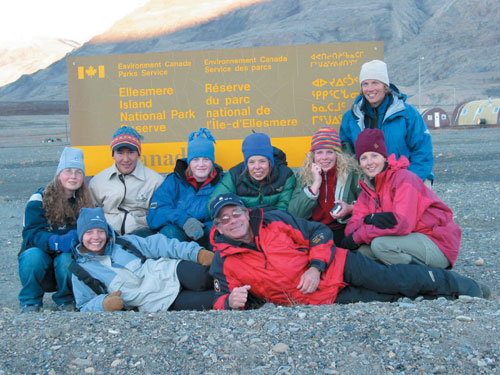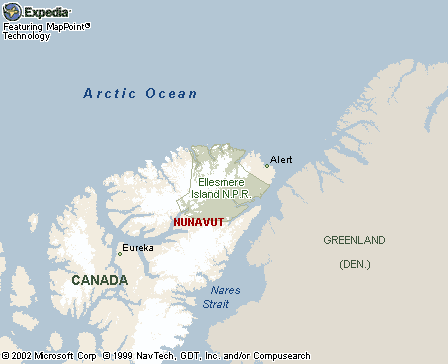|
|
Canku Ota |
|
|
(Many Paths) |
||
|
An Online Newsletter Celebrating Native America |
||
|
September 21, 2002 - Issue 70 |
||
|
|
||
|
Inuit teens from Nunavut learn new things about wildlife and fellow students
|
||
|
by Miriam Hill of Nunatsiaq
News
|
||
|
credits: Some of
the participants in the Students on Ice expedition at Ellesmere Island
national park reserve. Photo courtesy Geoff Green
|
|
It was there he saw an advertisement for Students on Ice, a Canadian organization that takes high school students and teachers on educational trips to the Earth’s poles. In the hopes of showing youth the importance of climate change and environmental issues, students, teachers and staff board a ship for two weeks to discover what the planet has to offer. "Aw, it was just awesome," Rankin’s Tattuinee said in a phone interview. "It was lots of fun and I met lots of people." Tattuinee joined this year’s Arctic expedition, from Aug. 15 to 29. Twenty students met in Ottawa to embark on a learning adventure that would take them from Resolute to Lancaster Sound, to Greenland, to Grise Fiord and even to Ellesmere Island. "I was really quiet," Tattuinee said of the first day he met with students who had come from across Canada and even from the United States. "The other two people from Cambridge Bay and I were quiet and kind of kept to each other, not interacting with the others for the first few days." That quickly changed. For many it was the first time on a ship – a world-class ice breaker at that – and being with a group of people 24 hours a day, seven days a week would either bond them or rip them apart. The group dynamic, according to Students on Ice director Geoff Green, was incredible. "It was really neat to see kids from like Long Island [New York] becoming close friends with Derek [Ehaloak] from Cambridge Bay. Otherwise they’d never, ever get to know each other," he said. "They didn’t just get to know each other, but they really became best of friends so that was a neat outcome of the trip." There were four students from Nunavut on the trip: Ehaloak and Shauna Okalitana from Cambridge Bay, Tattuinee from Rankin, and Pauloosie Audlakiak from Iqaluit. The National Inuit Youth Council and Inuit Tapirisat Kanatami sponsored most of the Inuit students and the Kitikmeot Corporation helped to support one student. This year’s trip saw the group visit places in the Arctic they had never been before, including Qaanaaq in northern Greenland and Ellesmere Island National Park. "The weather seems to be better up there. As soon as you get north of 80 the fog and cold lift, at least for us it was bright, beautiful, sunny warm days when we were up there," Green said. "When we entered Tanquary Fiord, which takes you up to the ranger station, the fiord was glass, total glass and the reflection was perfect. People just stood out on the bow that day and couldn’t even speak it was so beautiful." But the trip wasn’t solely for sightseeing. The students attended lectures and helped collect scientific data. Alain Fontaine, an ornithologist with the Canadian Wildlife Service in Iqaluit was part of the education team. He had the students involved in a bird monitoring exercise. A couple of students would stand at the bow of the ship and act as observers. Any bird seen within a half circle at the bow was recorded. The species, as well as the number present was noted, as was the latitude and longitude. Fontaine took the data and entered it into a geographic information system to make maps. The data is useful, he said. Although they have nothing to compare it with right now, they’re hoping to collaborate with Students on Ice in future years and make survey results part of the CWS habitat program. The highlight of the trip for Fontaine was a stop at Coburg Island, a national wildlife area in the mouth of Jones Sound, just between Devon Island and Ellesmere, where murres congregate. "We get in the Zodiacs, we can barely see 100 feet or so and then just as we get maybe 500 metres from the colonies the wall of fog ends and it’s blue sky," he said. "The cliffs are really, really tall and they’re covered with birds. They’ve got barely any room – there’s no room to move around. Picture half a million birds on a half-mile cliff and they’re just jam-packed one on top of one another, literally." His excitement was contagious. Since the trip Fontaine said he’s been getting e-mails from many of the students telling him they’re looking at birds and borrowing binoculars from their parents. The students also learned the history of the area and engaged in topical discussions about climate change and global warming. Sixteen-year-old Derek Ehaloak of Cambridge Bay said even though he lives in the Arctic he learned a variety of things, from plant and bird names to dealing with sea sickness. "Everything interested me. It was great," he said, although the three students from New York City kept asking the Arctic students if they already knew everything. Ehaloak saw his first polar bear from the bow of the ship, he said, as it hid behind a pressure ridge. "I really learned that I loved the North," he said, "and how awesome it is. It’s amazing the opportunities we have here." Tattuinee, who took more than 1,000 digital images and 10 rolls of film, said he also learned things about himself on the trip. "I guess I have to try and be more open, experience new things and not keep to myself," he said. The 20 students remain in regular contact through phone calls and e-mails. Students on Ice is embarking on an Antarctic
adventure in December.
|
||||
|
|
||
|
|
||
| Canku Ota is a free Newsletter celebrating Native America, its traditions and accomplishments . We do not provide subscriber or visitor names to anyone. Some articles presented in Canku Ota may contain copyright material. We have received appropriate permissions for republishing any articles. Material appearing here is distributed without profit or monetary gain to those who have expressed an interest. This is in accordance with Title 17 U.S.C. section 107. | ||
|
Canku Ota is a copyright © 2000, 2001, 2002 of Vicki Lockard and Paul Barry. |
||
 |
 |
|
|
The "Canku Ota - A Newsletter Celebrating Native America" web site and its design is the |
||
|
Copyright © 1999, 2000, 2001, 2002 of Paul C. Barry. |
||
|
All Rights Reserved. |
||
 Brian
Tattuinee’s adventure began at a café in Rankin Inlet.
Brian
Tattuinee’s adventure began at a café in Rankin Inlet.